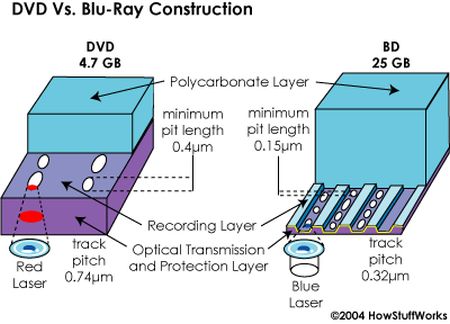Building a Blu-ray Disc
Blu-ray discs not only have more storage capacity than traditional DVDs, but they also offer a new level of interactivity. Users will be able to connect to the Internet and instantly download subtitles and other interactive movie features. With Blu-ray, you can:
- record high-definition television (HDTV) without any quality loss
- instantly skip to any spot on the disc
- record one program while watching another on the disc
- create playlists
- edit or reorder programs recorded on the disc
- automatically search for an empty space on the disc to avoid recording over a program
- access the Web to download subtitles and other extra features
Discs store digitally encoded video and audio information in pits — spiral grooves that run from the center of the disc to its edges. A laser reads the other side of these pits — the bumps — to play the movie or program that is stored on the DVD. The more data that is contained on a disc, the smaller and more closely packed the pits must be. The smaller the pits (and therefore the bumps), the more precise the reading laser must be.
Unlike current DVDs, which use a red laser to read and write data, Blu-ray uses a blue laser (which is where the format gets its name). A blue laser has a shorter wavelength (405 nanometers) than a red laser (650 nanometers). The smaller beam focuses more precisely, enabling it to read information recorded in pits that are only 0.15 microns (µm) (1 micron = 10-6 meters) long — this is more than twice as small as the pits on a DVD. Plus, Blu-ray has reduced the track pitch from 0.74 microns to 0.32 microns. The smaller pits, smaller beam and shorter track pitch together enable a single-layer Blu-ray disc to hold more than 25 GB of information — about five times the amount of information that can be stored on a DVD.
Each Blu-ray disc is about the same thickness (1.2 millimeters) as a DVD. But the two types of discs store data differently. In a DVD, the data is sandwiched between two polycarbonate layers, each 0.6-mm thick. Having a polycarbonate layer on top of the data can cause a problem called birefringence, in which the substrate layer refracts the laser light into two separate beams. If the beam is split too widely, the disc cannot be read. Also, if the DVD surface is not exactly flat, and is therefore not exactly perpendicular to the beam, it can lead to a problem known as disc tilt, in which the laser beam is distorted. All of these issues lead to a very involved manufacturing process.
For more detail: How Blu-ray Discs Work

